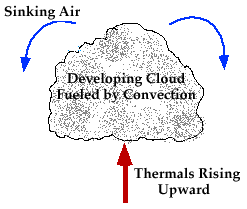|
|
. |
Convection
atmospheric motions in the vertical direction
In meteorology, convection refers primarily to atmospheric motions in the
vertical direction. As the earth is heated by the sun,
different surfaces absorb different amounts of energy and convection may
occur where the surface heats up very rapidly.
As the surface warms, it heats the overlying air, which gradually
becomes less dense than
the surrounding air and begins to rise.
 |
The bubble of relatively warm air
that rises upward from the surface is called a "thermal". |
A simple demonstration of condensation through convection
can be performed by placing a pot of water
on a heated stove. The burner represents the heating of the earth's
surface by the sun, while the water and the air above it represent the atmosphere.
As the bottom of the pot (earth's surface) begins to heat the water
(lower atmosphere), warmer and less dense water evaporates and
rises (thermal) into the drier, colder air above the pot (middle atmosphere).
This causes the thermals to cool and
water vapor within to condense, forming a small cloud, or steam, that is visible
above the pot of heated water.
[Image: convective cloud (83K)]
Photo by: Bramer
This same process occurs in the real atmosphere
as the water vapor within rising thermals
condenses to form a cloud,
as occurred in the example shown above.

introduction
|
|

cyclones
|
|


